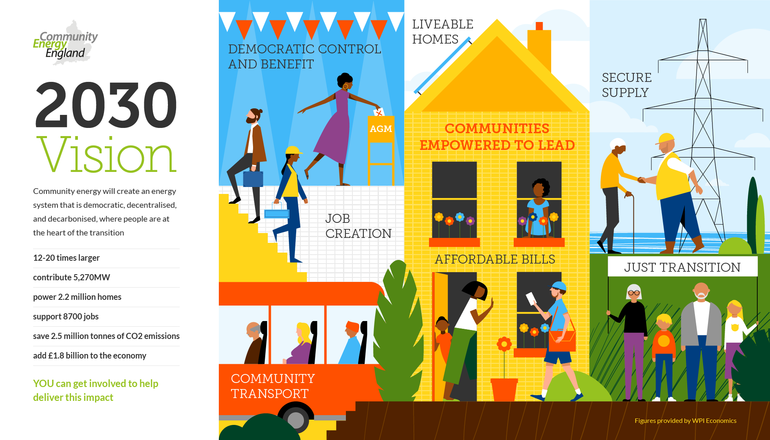By 2030, community energy should be powering the equivalent of 2.2 million homes (the population of West Yorkshire) by contributing 5,270 MW to the energy system, supporting 8,700 jobs, saving 2.5 million tonnes of CO2 emissions and adding over £1.8 billion to the economy each year.

Community Energy England’s Community Energy 2030 Vision, launched alongside the State of the Sector report during Community Energy Fortnight, calls for a transformation of the energy system where people are put at the heart of the energy system, as consumers, but also, crucially, as active participants in and beneficiaries of a more decentralised, distributed and democratised energy system. This vision builds upon the findings of ‘The Future of Community Energy’ – commissioned by SP Energy Networks from the independent research consultancy WPI Economics.
In 2014, the government envisaged 1 million homes powered by community energy by 2020. However, due to policy set backs (such as removal of ROCs, the Feed-in Tariff, Export Tariff, the Urban Community Energy Fund and Tax Relief, punitive business rates on root-top solar, planning constraints on on-shore wind and increasing VAT on solar panels, batteries and ‘energy saving measures’ from 5% to 20%) we have only achieved 10% of that as the State of the Sector report shows. We must not make this mistake again. UK Government needs to offer policy and financial support that recognises community energy’s essential role in the net-zero transition and the huge social and community benefit it brings.
Community energy organisations are created and run by local people who understand the needs of their community and are trusted by the community to advise, engage and offer new opportunities.
The Committee on Climate Change’s Net Zero Report states, “It will not be possible to get close to meeting a net-zero target without engaging with people...There is currently no government strategy to engage the public in the transition to a low-carbon economy. This will need to change." Community energy is key to this engagement.
If “the future of energy is local”, as ministers have stated, then enabling local actors will be key, to create local generation and do the energy efficiency and local grid management that is essential to rolling out more zero-carbon energy.
With the impacts of Covid-19, the community energy sector is likely to see fewer low carbon projects deployed in 2020. But the sector’s response to the crisis demonstrates the vital role community organisations play in supporting and delivering critical local services and maintaining community cohesion. They also hold the key to Building Back Better, local ‘levelling up’ and increased energy justice as well as to achieving the net-zero transition.
Until recent years the community energy sector had grown exponentially since 2012, generating local energy from wind, solar, water, anaerobic digestion, wood, saving energy, providing energy storage, low carbon transport, community heat, as well as energy education, innovation projects and large amounts of community benefit. According to Community Energy England and Community Energy Wales’ latest State of the Sector research, which was sponsored by SP Energy Networks, community energy in the UK currently contributes 265MW of renewable electricity generation and 13 MW of heat. Across England, Wales & Northern Ireland, community energy contributes at least £4.6 million to local economies through community benefit funds and cost savings, engaging 234,000 local people in energy efficiency, and developing 39 energy storage projects and 47 low carbon transport projects - all using its own people power and minimal external support.
With the right backing and suitable support mechanisms, community energy organisations can harness the immense passion, ingenuity and commitment of their employees and volunteers, engage their communities, accelerate the net-zero energy transition to benefit communities and local people and realise our shared 2030 Vision.